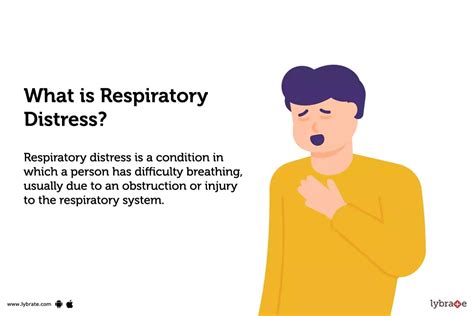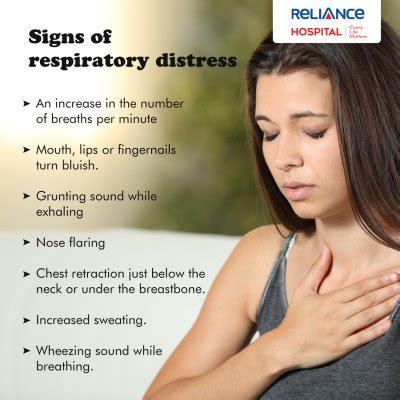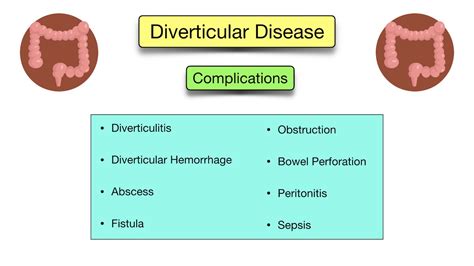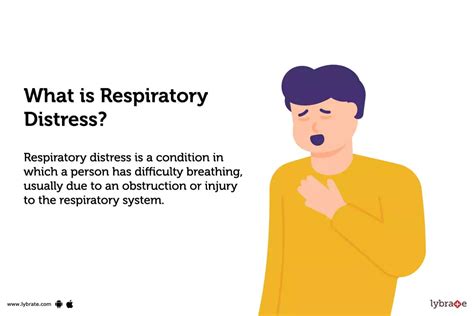Intro
Learn about Respiratory Distress Disease symptoms, causes, and treatment. Identify signs of breathing difficulties, lung failure, and respiratory infections, and discover management options for chronic conditions like COPD and pneumonia.
Respiratory distress is a serious medical condition that affects millions of people worldwide. It is a broad term that encompasses a range of symptoms and conditions that affect the lungs and respiratory system. Respiratory distress can be acute or chronic, and it can be caused by a variety of factors, including infections, allergies, and underlying medical conditions. In this article, we will explore the symptoms of respiratory distress disease, its causes, and treatment options.
Respiratory distress can manifest in different ways, and its symptoms can vary depending on the underlying cause. Some common symptoms of respiratory distress include shortness of breath, wheezing, coughing, chest tightness, and fatigue. In severe cases, respiratory distress can lead to respiratory failure, which can be life-threatening if left untreated. It is essential to seek medical attention immediately if you or someone you know is experiencing symptoms of respiratory distress.
The importance of recognizing the symptoms of respiratory distress cannot be overstated. Early detection and treatment can significantly improve outcomes and reduce the risk of complications. Moreover, understanding the causes of respiratory distress can help individuals take preventive measures to reduce their risk of developing the condition. In the following sections, we will delve into the causes, symptoms, and treatment options for respiratory distress disease.
Understanding Respiratory Distress

Causes of Respiratory Distress
The causes of respiratory distress can be broadly categorized into two groups: respiratory and non-respiratory. Respiratory causes include conditions that directly affect the lungs and respiratory system, such as asthma, COPD, and pneumonia. Non-respiratory causes include conditions that indirectly affect the lungs and respiratory system, such as heart failure, kidney disease, and neurological disorders.Symptoms of Respiratory Distress

Diagnosing Respiratory Distress
Diagnosing respiratory distress typically involves a combination of physical examination, medical history, and diagnostic tests. The doctor may use a stethoscope to listen to the lungs and a pulse oximeter to measure oxygen levels in the blood. Diagnostic tests may include chest X-rays, computed tomography (CT) scans, and pulmonary function tests.Treatment Options for Respiratory Distress

Preventing Respiratory Distress
Preventing respiratory distress involves taking steps to reduce the risk of developing underlying conditions. Some ways to prevent respiratory distress include: * Quitting smoking * Avoiding exposure to pollutants and allergens * Getting vaccinated against respiratory infections * Practicing good hygiene to reduce the risk of infection * Managing underlying medical conditionsComplications of Respiratory Distress

Managing Respiratory Distress
Managing respiratory distress involves working closely with a healthcare team to develop a treatment plan. This may include lifestyle modifications, such as quitting smoking and avoiding pollutants, as well as medical treatments, such as oxygen therapy and medications.Living with Respiratory Distress

Coping with Respiratory Distress
Coping with respiratory distress involves finding ways to manage symptoms, reduce stress, and improve overall quality of life. Some ways to cope with respiratory distress include: * Practicing relaxation techniques, such as deep breathing and meditation * Staying physically active to improve lung function and overall health * Connecting with others to reduce feelings of isolation and loneliness * Seeking support from mental health professionals to manage anxiety and depressionWhat are the symptoms of respiratory distress?
+The symptoms of respiratory distress include shortness of breath, wheezing, coughing, chest tightness, and fatigue.
What causes respiratory distress?
+Respiratory distress can be caused by a variety of factors, including respiratory infections, chronic obstructive pulmonary disease (COPD), asthma, and pneumonia.
How is respiratory distress treated?
+The treatment options for respiratory distress depend on the underlying cause and may include oxygen therapy, medications, mechanical ventilation, and pulmonary rehabilitation.
In summary, respiratory distress is a serious medical condition that requires prompt attention and treatment. By understanding the symptoms, causes, and treatment options for respiratory distress, individuals can take steps to reduce their risk of developing the condition and improve their overall quality of life. If you or someone you know is experiencing symptoms of respiratory distress, it is essential to seek medical attention immediately. We encourage you to share this article with others and to comment below with any questions or concerns you may have.
